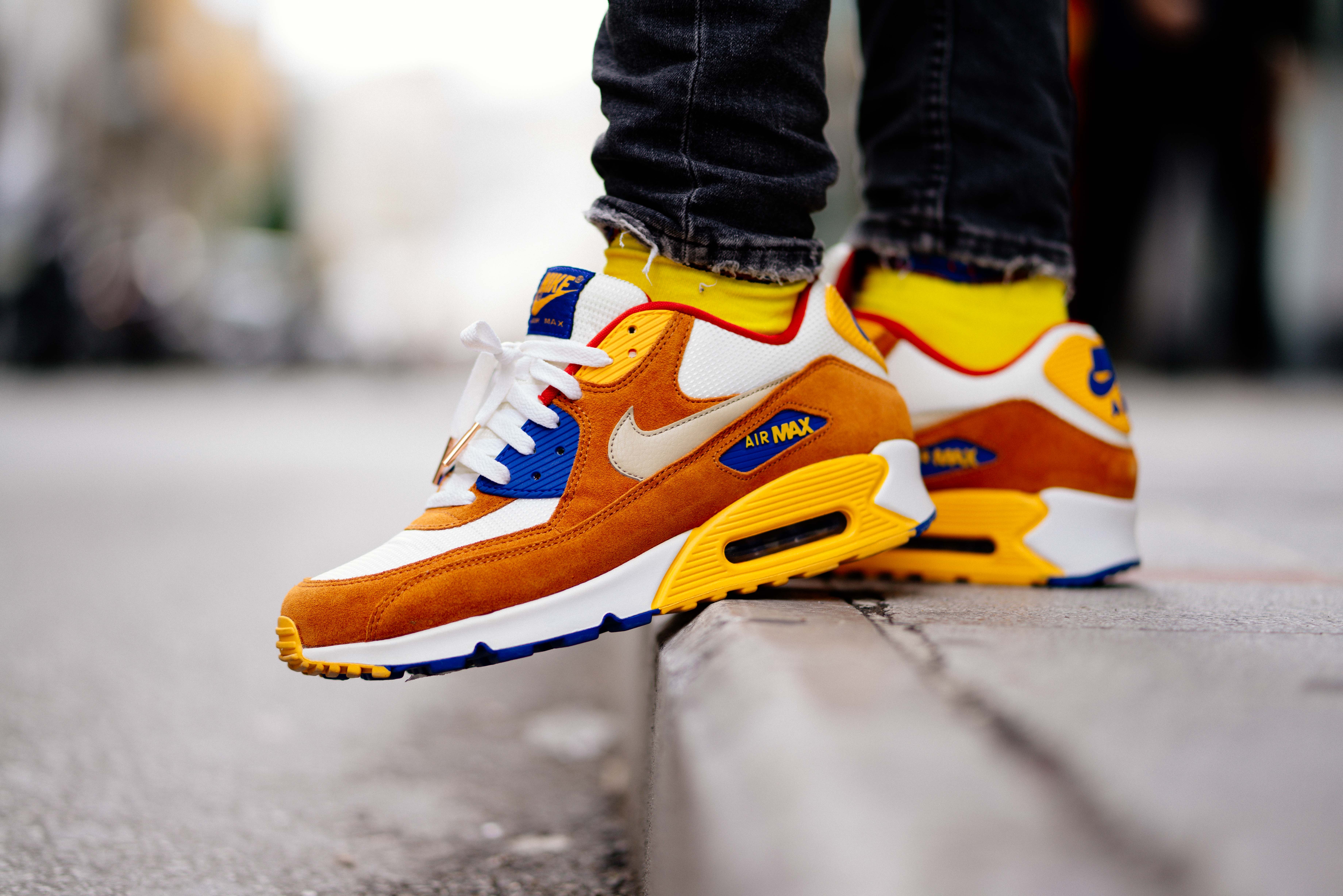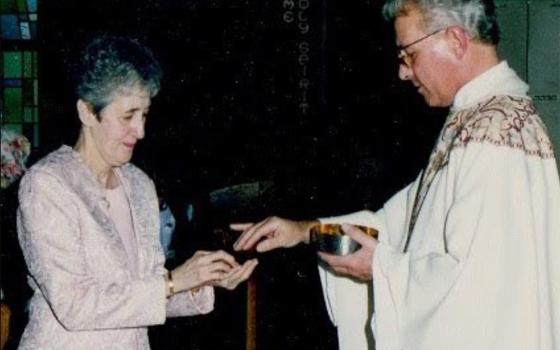
Nike Air Max in brown and white (Unsplash/Lefteris Kallergis)
In my family, I am "the one with the sneakers." That was my childhood way of distinguishing myself from my siblings. It was my first foray into the construction of my identity, somewhere around the age of five. One summer I even convinced my Mom to buy me the indestructible shoes I long coveted — white low top oxford Converse Chuck Taylor All Stars — because something about their vulcanized rubber sole and toe cap screamed durability, especially when playing ball on concrete sidewalks and asphalt school yards. They were affordable and practical. To this day, my Chucks root me in memories of home and of my parents. They also signal the parts of my identity that draw me into play, sport and popular culture as sources of theologizing.
The ties between sneakers and identity are as old as the genre itself, a theme highlighted by Out of the Box: The Rise of Sneaker Culture, a touring exhibit curated by Toronto's Bata Shoe Museum. While I am not a Sneakerhead (I wear them into the ground thus insuring they have no value as collectibles), I do regret missing the exhibition the one time our travel schedules crossed in Louisville, Kentucky. Hosted by the Speed Art Museum in the Fall of 2016, the online gallery hints at the complex story of this ubiquitous yet multivalent symbol of our equally complicated daily living. In her insightful Atlantic magazine commentary on the exhibit, fashion historian Kimberly Chrisman-Campbell observes "over the last 200 years, sneakers have signified everything from national identity, race, and class to masculinity and criminality; put simply, they are magnets for social and political meaning, intended or otherwise, in a way that sets them apart from other types of footwear."
The role of sneakers as "canvases for political commentary and projection" have been on display this summer in ways that underscore contested relationships with identity and reflect the signs of these our troubled times. Just days before the Fourth of July, NIKE Inc., a USA-based multinational corporation known for athletic footwear, equipment and sportswear, pulled its limited edition Air Max 1 Quick Strike USA sporting a Revolutionary War era flag stitched above the heel. In an updated statement Nike attributed its decision to halt distribution to concerns that the shoe could "unintentionally offend and detract from the nation's patriotic holiday." Controversy over the sneaker intensified when the Wall Street Journal reported that the motivation behind the scenes was allegedly when "NFL star-turned-activist Colin Kaepernick told the company it shouldn't sell a shoe with a symbol that he and others consider offensive." Kaepernick, the professional quarterback made infamous by detractors for his kneeling during the national anthem at football games, remains unsigned by any team in the NFL but still holds celebrity status with lucrative endorsements from Nike.
Objections to the iconography centered on matters of race and contemporary usage. While to some, the early flag with its circle of 13 stars represented independence, to others it symbolized legacies of oppression inherent to a nation founded in support of slavery, on the forced relocation of indigenous populations and the degradation of black and brown bodies. Furthermore, as critics pointed out, the material culture of early Americana was being repurposed by some groups, citing examples that cut across white racist, nationalist and xenophobic extremism. Considering Kaepernick's public commitments over the past few years, sensitivity to these issues would resonate with his social conscience. Kaepernick became a lightning rod in a debate about political correctness though he did not publicly utter a word on the matter of the patriotic sneaker.
Advertisement
The shoe recall by Nike was actually the second in less than two months, a fact missed by many commentators. In late May, the company pulled the Nike Air Force 1 "Puerto Rico" 2019 two weeks before the annual New York Puerto Rican Day Parade. The shoe was intended as an homage to celebrate the parade and the culture of the people of the island and in diaspora. The plan backfired when the design came under scrutiny amid charges of cultural appropriation and plagiarism. The pattern used on the shoe was not of Puerto Rican origin, it was a textile print distinctive of the indigenous Guna people of Panama! Called out on social media and chastised by an online petition, Nike was forced to cancel the release of the shoe and "apologize for the inaccurate representation of the design origin." With one sneaker, the company had managed to offend Puerto Ricans, Panamanians and violate the intellectual property of indigenous women.
Reading between the laces of these two sneaker fiascos reveals more than a tale of corporate failure to comprehend the connections between identities and their representation in the stuff of life. Nike is well aware of the relationship between identity and their products. The creation of limited edition shoes that commodify national, cultural and personal expression is a staple of their product line. For example, in late 2018 the company released two different sneakers celebrating Dominican identity under two separate brands. The Nike Air Force 1 "De Lo Mío", dropped in November with particular attention to the large Dominican community in New York City and the consultative process that made it, for the community, "finally a shoe for us, by us." Taking its name from a popular expression in Dominican Spanish indicating "one of my own," Nike described the shoe as:
"[T]he perfect platform to pay homage to one of NYC's most influential cultures and communities: Dominicans. … These unsung heroes who've made the migration from the DR to NYC are represented with a lenticular University Red and Sport Blue Swoosh, symbolizing a vibrant yet smooth transition from one island to the next."
Earlier in the Fall of 2018 Nike marked Hispanic Heritage Month with the Converse Chuck Taylor "Puro Platano" designed by Ray Polanco Jr. Through his self-narrated web story Polanco effectively conveys yet another dimension of this canvas platform — the sneaker as art in terms of creative process, design and performance. He eschews the typical flag palette and turns instead to colors and images drawn from his Dominican daily life and kitchen:
"[T]he green upper represents the platano in produce form. while growing up, there was always a bowl of platanos sitting as the centerpiece to our dinner table. The golden converse patch and eyelets speak to cooked platanos in the form of popular dominican dishes — tostones (fried version) and mangu (similar to mashed potatoes, but with platanos)."
Subtle details known to insiders encode cultural identity, from the "lace locks that look like domino gaming pieces" on the Air Force 1 De Lo Mío to the recipes of a Dominican cocina intimated in the "Puro Platano" Chuck. To wear either pair is a performance of one's identity, an evocation of memory, a public assertion that wherever one's shoes may take them they stand on Dominican land.
Nike benefits greatly from cultural exploitation that is exacerbated by profit margins driven higher through the production of limited edition shoes. Among the messages sent is that identity can be managed as an in-the-box collectible. What escapes Nike's control is the performance of the sneaker wearer. The relationship between identity and footwear is further complicated by the performative dimension that occurs in ever shifting contexts.
"To wear either pair is a performance of one's identity, an evocation of memory, a public assertion that wherever one's shoes may take them they stand on Dominican land."
— Carmen Nanko Fernández
In the cases of the two recalled shoes, a frequent refrain from critics decried the lack of research. Who had failed to understand that a sneaker with a flag co-opted by groups who constructed patriotism in racially exclusive ways spelled a branding dilemma in a post-Charlottesville era? Who missed the patriot militia groups functioning as vigilantes patrolling USA southern borders, some bearing insignia and flags strikingly similar to those depicted in honor of the Fourth of July on the back of a shoe? Who thought no one would catch a copyright infringement of the intellectual property of an indigenous community whose designs are both famous and protected? Who believed Puerto Ricans and Panamanians were interchangeable and neither would notice the forced assimilation? Even in the case of the Dominican Air Force 1, why in this age would Nike presume that the transition from one island in the Caribbean Sea to another at the confluence of the Harlem, East and Hudson Rivers would be smooth for a significantly diasporic AfroLatin@ population?
In a 1993 essay, public intellectual Michael Eric Dyson astutely noted "at the juncture of the sneaker, a host of cultural, political, and economic forces and meanings meet, collide, shatter …" (467) If anything, the signs of our own times call for greater attention to the details and to the performances played out in sneaker codes. Sneakers are never just sneakers!
[Carmen M. Nanko-Fernández is professor of Hispanic theology and ministry, and director of the Hispanic Theology and Ministry Program at Catholic Theological Union (CTU) in Chicago. The author of Theologizing en Espanglish (Orbis), she is currently completing ¿El Santo?: Baseball and the Canonization of Roberto Clemente (Mercer University Press).]
Editor's note: We can send you an email alert every time Theology en la Plaza is posted to NCRonline.org. Sign up here.








